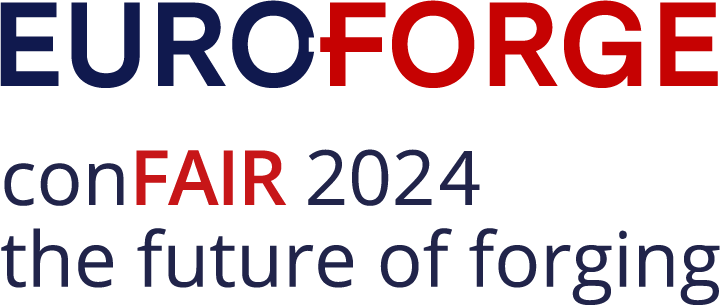Final Programme
All members of the forging family are cordially invited to join in this trendsetting event and use the opportunity to meet
and exchange on challenges and on innovative technical solutions.
The programme will offer scientific sessions with latest highlights of the forging industry as well as industrial sessions from top-class companies.
You can also download the full programme here.
| TUE 22.10.2024 | ||||
| Plenary | Breakout 1 | Breakout 2 | ||
| 09:00-09:30 | E X H I B I T I O N O P E N |
Opening & Welcome Attilio Fresia / Tobias Hain EUROFORGE | ||
| 09:30-10:00 |
Back to the Future? The Transformation of Automotive MarketsFelix Kuhnert PwC View abstract and vita |
|||
| 10:00-10:30 |
Scientific Keynote Andrea Ghiotti University of Padova View abstract and vita |
|||
| 10:30-11:00 | coffee break | |||
| 11:00-11:30 | ||||
| 11:30-12:00 |
ORI MARTIN SPA Integrated companies in a model of efficient green way of steel production View abstract |
ACCIAIERIE BERTOLI SAFAU S.p.A. Committed to sustainability to ensure competitiveness: the ABS plan for 2030 View abstract |
ACCIAIERIE VENETE S.p.A. The Acciaierie Venete Decarbonization Plan View abstract |
|
| 12:00-12:30 |
OVAKO AB Reaching zero emissions for forged and rolled engineering steel products View abstract |
VECCHIATO OFFICINE MECCANICHE Vecchiato Straightening machine View abstract |
SIDENOR Heat Up the Innovation, Cool Down the Emissions: The Heat Treatment Future View abstract |
|
| 12:30-13:00 | lunch break | |||
| 13:00-13:30 | ||||
| 13:30-14:00 | ||||
| Sustainability in Forging | ||||
| 14:00-14:30 |
Eliminating energy-intense process steps by innovative steel Steve Ooi Ovako, Sweden View abstract and vita |
|||
| 14:30-15:00 |
Decarbonising the forging industry using thermal energy storage-based waste heat recovery technology Derek Bond University of Birmingham Centre for Energy Storage, UK View abstract and vita |
|||
| 15:00-15:30 | coffee break | |||
| 15:30-16:00 | ||||
| 16:00-16:30 |
YANGLI GROUP CORPORATION LIMITED The Forging and Automation Technological Innovation from Yangli View abstract |
BUDERUS EDELSTAHL GMBH High Cleanliness Special Tool Steels for variousapplications View abstract |
KIND SPECIAL ALLOYS ITALIA SRL Premium tool steel solutions for improved performanceof forging dies View abstract |
|
| 16:30-16:50 | Regional report ChinaZhang Jin | |||
| 16:50-17:10 | Regional report North AmericaAngela C. Gibian | |||
| 17:10-17:30 | Regional report IndiaYash Munot | |||
| 17:30-17:50 | Regional report JapanKunio Kakuta | |||
| 17:50-18:10 | Regional report EuropeTobias Hain | |||
| 18:10-22:00 | Get together | |||
| WED 23.10.2024 | ||||
| Plenary | Breakout 1 | Breakout 2 | ||
| Forging technologies in new mobility | ||||
| 09:00-09:30 | E X H I B I T I O N O P E N |
Project TRANSFUGE (Stellantis)Pierre-Emmanuel Aba-Perea IRT Institute, France View abstract and vita |
||
| 09:30-10:00 |
Development of a Compact e-Axle for Heavy Duty Trucks, E-mobility forgings at Commercial Vehicles and New Generation Automated Forging line concept Gürbüz Güzey, Rolf Döbereiner Parsan, Turkey AVL List, Austria View abstract and vita |
|||
| 10:00-10:30 |
ACCIAIERIE BERTOLI SAFAU S.p.A. Sustainable Product and Process Innovation in Steel Industry View abstract |
LASCO Umformtechnik GmbH Incremental massive forming processes - principle and application View abstract |
SMS group iForge – Automated Final Inspection View abstract |
|
| 10:30-11:00 | coffee break | |||
| 11:00-11:30 | ||||
| Digitalization and AI in Forging | ||||
| 11:30:12:00 |
Creating a digital twin of a forging platform for operator training in a VR-environment Cyrille Baudouin Arts et Métiers Institute of Technology, Université de Lorraine View abstract and vita |
|||
| 12:00-12:30 |
Towards a hybrid FEM-Machine Learning solution for enhanced simulation of manufacturing processes José Alves Transvalor, France View abstract and vita |
|||
| 12:30-13:00 | lunch break | |||
| 13:00-13:30 | ||||
| 13:30-14:00 | ||||
| 14:00-14:30 |
ACCIAIERIE VENETE S.p.A. Acciaierie Venete´s Sustainable Steelmaking View abstract |
MECOLPRESS S.p.A. Experiences about ferrous and not ferrous hot metal forging View abstract |
||
| 14:30-15:00 |
FICEP SPA Flexible Production Lines for Precision Forging View abstract |
SCHULER PRESSEN GmbH Turnkey Projects for the Forging Industry - A Comprehensive Approach View abstract |
||
| 15:00-15:30 | coffee break | |||
| 15:30-16:00 | ||||
| 16:00-16:30 |
EASYDUR SRL A study over the advantages of automatic hardness testers with milling system for forgings and castings View abstract |
ASIL CELIK SAN VE TIC AS Novel Steel Grade Design and Use Case Demonstration Towards Improving the Process Chain and Reducing the Environmental Impact via Decarbonization View abstract |
||
| Innovations in Forging Technology | ||||
| 16:30-17:00 |
Efficient component manufacturing by process combination of casting and thermomechanical treatment Tim Lehnert Fraunhofer-IWU, Germany View abstract and vita |
|||
| 17:00-17:30 |
Simulation et implementation of the near-isothermal forging Stéphane Magron CETIM, France View abstract and vita |
|||
| 17:30-18:00 | Closing Attilio Fresia / Tobias Hain EUROFORGE |
|||

Legal Organiser & PCO
Time Change GmbH
Bogenstraße 54a
20144 Hamburg
Germany
E: confair@time-change.com
Hosting Confederation
EUROFORGE AISBL
Tobias Hain
Secretary General
EUROFORGE Member Associations